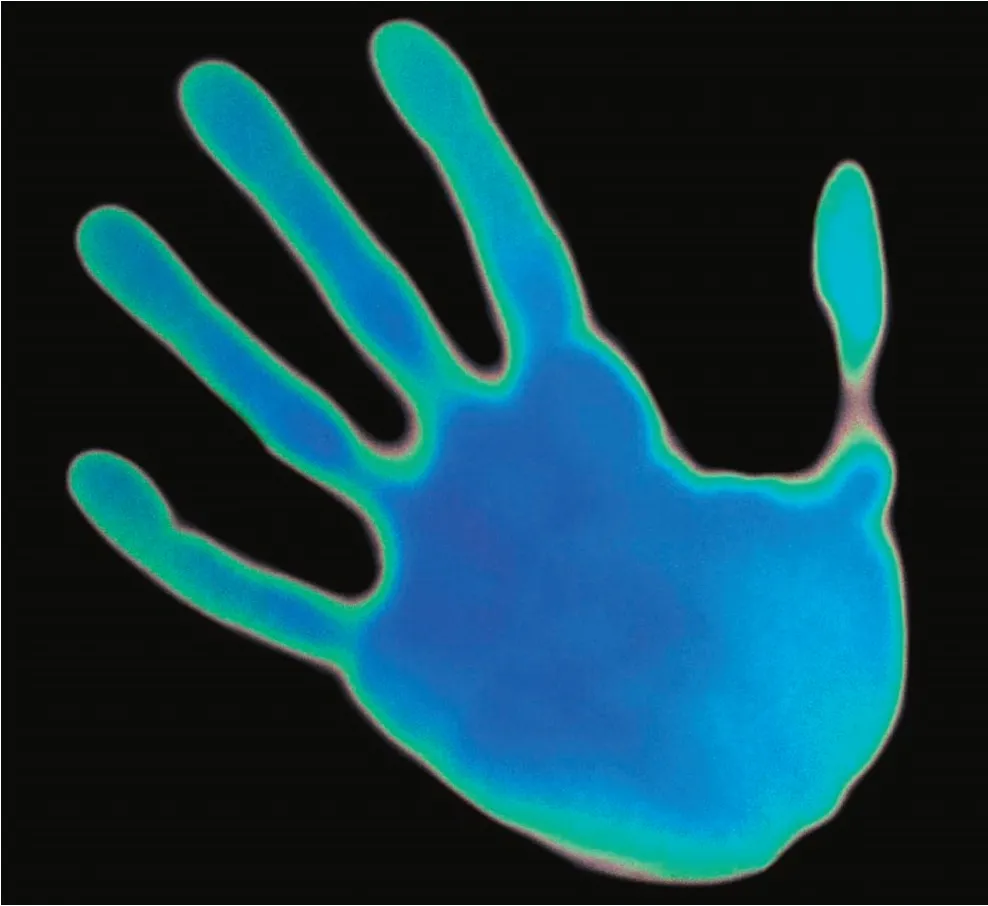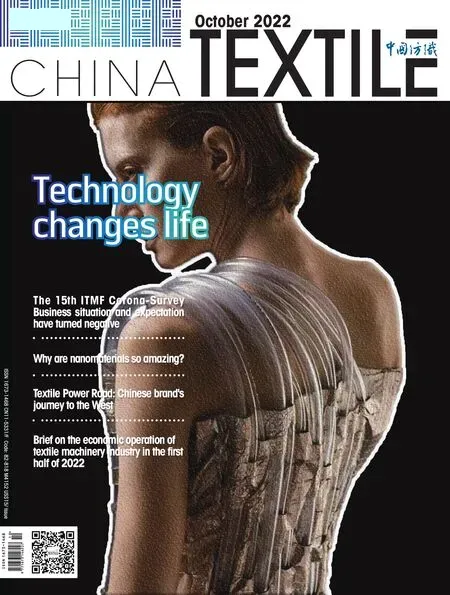Chromic materials,magicians in life
By Zhao Xinhua
Chromic materials (CM) are the general terms used to refer to the materials that change their color ac—cording to the outside environmental conditions and stimuli.Chromic ma—terials are the materials that radiate,erasing their color because they induct color caused by the external stimuli.According to the stimuli type,chromic materials can be categorized as photo—chromic,thermochromic,electrochro—mic,piezochromic,solvatechromic,and carsolchromic,which change their color by the external stimulus of light,heat,electricity,pressure,liquid,and an electron beam,respectively.
"Invisibility cloak"
Photochromic materials are color—less in a dark environment and emit reversible color change when activated by ultraviolet radiation.The ultravio—let radiation changes the molecular structure of the photochromic materi—als,and it exhibits color.When the light source is taken away,the color disappears.Photochromic materials in the textile field,not only used in UV protection clothing,but also in fash—ion.Photochromic materials are combined with textile fibers to produce color—changing yarns,which is used as raw material to design clothing and bags with color—changing effect,and can obtain visual effects that cannot be achieved by dyeing and printing process and other materials.
After entering the 21st century,the development of color—changing clothing has made greater progress,such as a kind of photochromic dye,which can make synthetic fabric "dye" the color of the surrounding scenery,and blend the clothing into the natural scenery.Photochromic textiles,military camouflage clothing and other products have entered the market,favored by consumers.At pres—ent,China has gradually improved the related processing technology,together with Britain,the United States and Japan,become a few countries that can produce color—changing intelligent textile material.
Photochromic materials are not only widely used in the design of clothing and bags,but also common in our daily life,such as car film,sunscreen glasses,color—changing jewelry,color—changing nail polish and so on.Photochromic materials enrich our daily life with the variability of color.Taking sunglasses as an example,self—chromaticity can be adjusted according to the level of ultraviolet radiation intensity,so as to achieve the purpose of better eye protection.

Whenever we talk about photochromic materials,thermochromic materials are also referred.In ther—mochromic materials,the liquid crystal type and the molecular rearrangement type are thermochromic sys—tems in textiles.The thermochromic materials can be made as semiconductor compounds,from liquid crys—tals or metal compounds.The change in color occurs at a predetermined temperature,which can be varied.
Thermochromics can be applied to textiles fabrics using dyes directly by exhaust method or continuous method,screen printing,microencapsulation are some techniques for application in fabrics,even it can be applied in core—spun yarns where core fiber contains microencapsulated thermochromic materials.
The critical temperature of a thermochromic dye is the temperature at which the colour starts chang—ing in response to the temperature stimuli.This is particularly important because the end use applica—tion of the thermochromic dyes will depend primarily on the critical temperature.For instance,by select—ing one or more of thermochromic dyes whose criti—cal temperature is near human body temperature,for applying on textiles,one could create textiles that would respond to human touch,emotional and psychological response.Similarly,by mixing thermo—chromic dyes having various critical temperatures and applying it on textiles,a series of color change effects can be brought out at different tempera—ture levels.Moreover,through right choice of criti—cal temperature of thermochromic dyes for special applications like military applications,the required chameleonic effect can be achieved to match with the surroundings.Likewise a number of applications may be explored by the correct choice and combina—tions of thermochromic dyes having different critical temperature limits.
A team of researchers from Seoul National Uni—versity and Hanyang University in South Korea has de—veloped a chameleon—inspired soft robot that changes color in real time according to its background.This re—search can be applied to military,architecture,fashion and other fields.The researchers used a new strategy for developing artificial chameleons,they integrated thermochromic liquid crystal inks with longitudinally stacked,patterned multilayer silver nanowire heaters(which they abbreviated to ATACS),combined with the color sensor and feedback control system,the "artificial chameleon skin" is made and applied to a soft robot,forming the chameleon robot.

Instantaneously matching chameleons to natural colors offers an exciting solution for the next generation of "artificial camouflage," a technology that is popular not only in military applica—tions but also in architecture,art,fashion and outdoor activities.
In the field of civil clothing,we can also achieve the purpose of health monitoring by combining intelligent color—changing clothing with sensor parts.Sportswear designed to monitor endurance and an athlete's skin temperature,for example,could monitor physical fatigue levels in real time by changing the color of the garment.In addition,the application of color—changing materials in disease diagnosis has also aroused great interest.For example,the tem—perature of various parts of the human body is an important basis for disease diagnosis.Scientists use liquid crystal thermochromic materials to design textile patches that can be sensitive to the temperature of the human body for early detection of infection and blood circulation changes.
Clothing navigation
Chromic materials are one of the challenging material groups when thinking about future textiles.Textiles with chro—mic materials may find applications in design area and fancy clothes,sports garments,workwear,soldier and weapons cam—ouflage fabrics,and technical and medical textiles.Chromic ma—terials can be applied into the textiles by inserting them into the fiber matrix using a traditional dyeing technique,blending them with a polymer and then extruding or wet spinning them into photochromic fibers,mixing them with a resin and surface coating them onto a fabric surface,and printing.The combination of SMMs and thermochromic coating is an interesting area,which produces shape and color changes of the textile material at the same time.
In electrochromic materials,the variation of the optical properties is caused by applied electric potentials.Electro—chromic materials may demonstrate different and revers—ible colors in response to the applied voltage or current.The electrochromic textiles are produced by weaving electro—chromic fibers into textiles,or they can be obtained directly on the conductive textile substrates.
A research team led by Professor Peng Huisheng from the Department of Polymer Science of Fudan University successfully integrated the preparation of display devices with the weaving process of fabrics in 2021,and integrated multifunctional micro—light—emitting devices at the inter—weaving points of polymer composite fibers,revealing the unique law of electric field distribution between the fiber electrode,and implementing the large—area flexible display fabric and intelligent integration system.Compared with traditional flat panel leds,the luminescent fiber diam—eter can be precisely adjusted between 0.2 mm and 0.5 mm,which determines its "ultra—fine and ultra—flexible" characteristics.The fabric woven with the fiber can be close to the irregular contour of the hu—man body,as light and breathable as ordinary fabric,ensuring good wearing comfort.


Wearing the "monitor",people with language barriers use it as a tool for efficient and convenient communication;in field work scenarios such as polar scientific expeditions and geological exploration,the location information can be displayed in real time with just a few taps on the clothes;map navigation is showed on clothes...These imaginary scenes may enter people's lives in the near future.
Piezochromic materials are functional materials that change the color of compounds due to pressure changes.The color of piezochromic fiber and fabric will change with some external mechanical forces such as grinding,friction and extrusion.The reason is that the fiber material will change its structure and form under the action of external force,resulting in charge transfer,thus leading to the change of itsfluorescence characteristics.It has great potential ap—plication value in the fields of mechanical and chemi—cal sensors,intelligent fabrics,health monitoring,entertainment and fashion.
Solvatechromism is the phenomenon where color changes when it comes to contact with a solvent or liquid.Materials that respond to water by changing color are also called hydrochromic,and smart textiles containing these kinds of materials can be used,e.g.,for swimsuits.
The British designer Amy Winters created a dress that started out white and became colourful when wet,using solvatechromic material.
The application of chromium material in textile and garment makes life wonderful and interesting.Meanwhile,it also faces many challenges,such as enriching color types,shortening response time and prolonging service life,which requires our continuous research and exploration.With the further develop—ment of science and technology,the function and performance of chromium material used in textile and clothing will be further improved,which will provide more convenience for our life.

